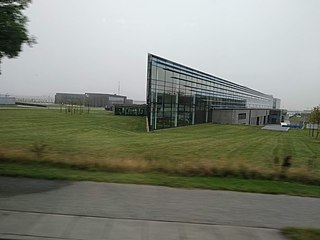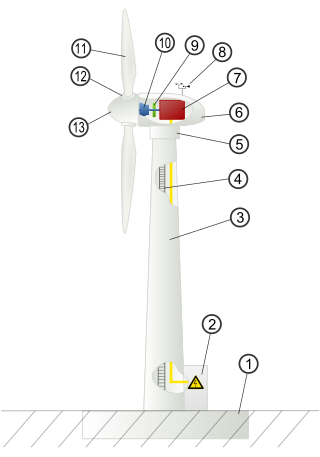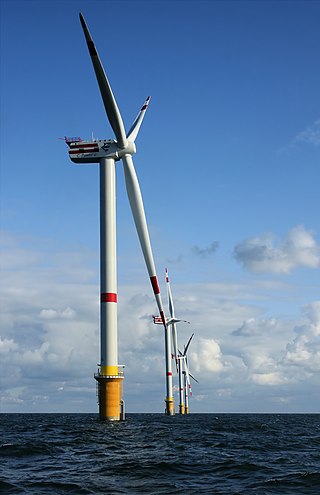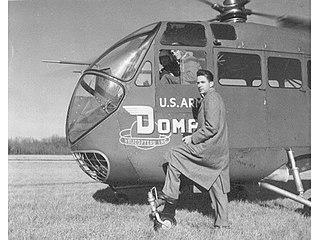
A tension-leg platform (TLP) or extended tension leg platform (ETLP) is a vertically moored floating structure normally used for the offshore production of oil or gas, and is particularly suited for water depths greater than 300 metres and less than 1500 metres. Use of tension-leg platforms has also been proposed for offshore wind turbines.

Anton Flettner was a German aviation engineer and inventor. Born in Eddersheim, Flettner made important contributions to airplane, helicopter, vessel, and automobile designs.

Vestas Wind Systems A/S is a Danish manufacturer, seller, installer, and servicer of wind turbines that was founded in 1945. The company operates manufacturing plants in Denmark, Germany, the Netherlands, Taiwan, India, Italy, Romania, the United Kingdom, Spain, Sweden, Norway, Australia, China, Brazil, Poland and the United States, and employs 29,000 people globally.

On a helicopter, the main rotor or rotor system is the combination of several rotary wings with a control system, that generates the aerodynamic lift force that supports the weight of the helicopter, and the thrust that counteracts aerodynamic drag in forward flight. Each main rotor is mounted on a vertical mast over the top of the helicopter, as opposed to a helicopter tail rotor, which connects through a combination of drive shaft(s) and gearboxes along the tail boom. The blade pitch is typically controlled by the pilot using the helicopter flight controls. Helicopters are one example of rotary-wing aircraft (rotorcraft). The name is derived from the Greek words helix, helik-, meaning spiral; and pteron meaning wing.

Wind turbine design is the process of defining the form and configuration of a wind turbine to extract energy from the wind. An installation consists of the systems needed to capture the wind's energy, point the turbine into the wind, convert mechanical rotation into electrical power, and other systems to start, stop, and control the turbine.
Wind power in Ohio has a long history, and as of 2016, Ohio has 545 megawatts (MW) of utility-scale wind power installations installed, responsible for 1.1% of in-state electricity generated. Over 1000 MW more were under construction or pending approval. Some installations have become tourist attractions. There has been a sudden increase in generating capacity, as the total wind power capacity in the state was just 9.7 MW in 2010. By 2019, there were 738 MW of capacity, which generated 1.71% of Ohio's electricity.

The Doman LZ-5 was a utility helicopter developed in the United States in the early 1950s by Doman Helicopters Inc. of Danbury, Connecticut. Despite the procurement of international manufacturing agreements, no series production of the aircraft ever occurred, and only three prototypes were built. Two of these were purchased by the United States Army as the YH-31, but eventually becoming VH-31.

A floating wind turbine is an offshore wind turbine mounted on a floating structure that allows the turbine to generate electricity in water depths where fixed-foundation turbines are not feasible. Floating wind farms have the potential to significantly increase the sea area available for offshore wind farms, especially in countries with limited shallow waters, such as Spain, Portugal, Japan, France and the United States' West Coast. Locating wind farms further offshore can also reduce visual pollution, provide better accommodation for fishing and shipping lanes, and reach stronger and more consistent winds.

A wind turbine is a device that converts the kinetic energy of wind into electrical energy. As of 2020, hundreds of thousands of large turbines, in installations known as wind farms, were generating over 650 gigawatts of power, with 60 GW added each year. Wind turbines are an increasingly important source of intermittent renewable energy, and are used in many countries to lower energy costs and reduce reliance on fossil fuels. One study claimed that, as of 2009, wind had the "lowest relative greenhouse gas emissions, the least water consumption demands and the most favorable social impacts" compared to photovoltaic, hydro, geothermal, coal and gas energy sources.

Offshore wind power or offshore wind energy is the generation of electricity through wind farms in bodies of water, usually at sea. There are higher wind speeds offshore than on land, so offshore farms generate more electricity per amount of capacity installed. Offshore wind farms are also less controversial than those on land, as they have less impact on people and the landscape.

GE Wind is a division of GE Vernova. The company manufactures and sells wind turbines to the international market. In 2018, GE Wind was the fourth largest wind turbine manufacturer in the world. Vic Abate is the CEO of GE Vernova’s Wind businesses.

The Sikorsky R-6 is an American light two-seat helicopter of the 1940s. In Royal Air Force and Royal Navy service, it was named the Hoverfly II.
Ming Yang Wind Power Group Limited is the largest private wind turbine manufacturer in China and the fifth largest overall in the country. The company was listed on the New York Stock Exchange from 1 October 2010 to June 22, 2016. It is developing the world's largest wind turbine with a capacity of 18 MW.

Starting in 1975, NASA managed a program for the United States Department of Energy and the United States Department of Interior to develop utility-scale wind turbines for electric power, in response to the increase in oil prices. A number of the world's largest wind turbines were developed and tested under this pioneering program. The program was an attempt to leap well beyond the then-current state of the art of wind turbine generators, and developed a number of technologies later adopted by the wind turbine industry. The development of the commercial industry however was delayed by a significant decrease in competing energy prices during the 1980s.

A variable speed wind turbine is one which is specifically designed to operate over a wide range of rotor speeds. It is in direct contrast to fixed speed wind turbine where the rotor speed is approximately constant. The reason to vary the rotor speed is to capture the maximum aerodynamic power in the wind, as the wind speed varies. The aerodynamic efficiency, or coefficient of power, for a fixed blade pitch angle is obtained by operating the wind turbine at the optimal tip-speed ratio as shown in the following graph.
Kurt Heinrich Hohenemser was a German-born American aerospace engineer and pioneer in the field of helicopter design.

Glidden Doman was an American aeronautical engineer and pioneer in helicopters and modern wind turbines. He founded one of America's original six helicopter companies after making major contributions to the use of Sikorsky helicopters during World War II. Doman Helicopters' most prominent achievement was the Doman LZ-5/YH-31 eight-place helicopter, which received FAA certification on December 30, 1955. The unique feature of this helicopter was its hinge-less but gimbaled, tilting rotor hub that greatly reduced stress and vibration in the blades and the whole helicopter.
The Gamma 60 wind turbine, a 1.5 MW two-bladed upwind horizontal axis wind turbine, was installed by Wind Energy Systems Taranto S.p.A. (WEST) at Alta Nurra, Sardinia, Italy in April 1992. Founded on original research and development work by NASA and Hamilton Standard, the Gamma 60 wind turbine was the world's first variable speed wind turbine with a teetering hinge.

Orbital Marine Power is a Scottish renewable energy company focused on the development and global deployment of its pioneering floating turbine technology. The O2 is Orbital's first commercial turbine and represents the culmination of more than 15 years of world leading product development in the UK. The 74 m long turbine is expected to operate in the waters off Orkney for the next 15–20 years with the capacity to meet the annual electricity demand of around 2,000 UK homes with clean, predictable power from the fast-flowing waters while offsetting approximately 2,200 tonnes of CO2 production per year. In a further ground-breaking element of the project, the O2 will provide power to the European Marine Energy Centre's onshore electrolyser to generate green hydrogen that will be used to demonstrate decarbonisation of wider energy requirements.
Many tidal stream generators have been developed over the years to harness the power of tidal currents flowing around coastlines. These are also called tidal stream turbines (TST), tidal energy converters (TEC), or marine hydro-kinetic (MHK) generation. These turbines operate on a similar principle to wind turbines, but are designed to work in a fluid approximately 800 times more dense than air which is moving at a slower velocity. Note that tidal barrages or lagoons operate on a different principle, generating power by impounding the rising and falling tide.























